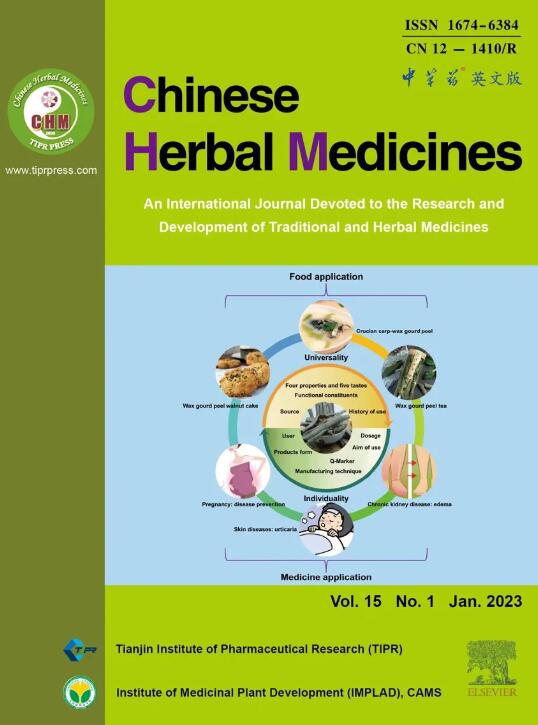Qingjie Fuzheng Granule prevents colitis-associated colorectal cancer by inhibiting abnormal activation of NOD2/NF-κB signaling pathway mediated by gut microbiota disorder
IF 4.7
4区 医学
Q1 CHEMISTRY, MEDICINAL
引用次数: 0
Abstract
Objective
This study investigates the efficacy and mechanisms of Qingjie Fuzheng Granules (QFG) in inhibiting colitis-associated colorectal cancer (CAC) development via RNA sequencing (RNA-seq) and 16S ribosomal RNA (rRNA) correlation analysis.
Methods
CAC was induced in BALB/c mice using azoxymethane (AOM) and dextran sulfate sodium (DSS), and QFG was administered orally to the treatment group. The effects of QFG on CAC were evaluated using disease index, histology, and serum T-cell ratios. RNA-seq and 16S rRNA analysis assessed the transcriptome and microbiome change. Key pharmacodynamic pathways were identified by integrating these data and confirmed via Western blotting and immunofluorescence. The link between microbiota and CAC-related markers was explored using linear discriminant analysis effect size and Spearman correlation analysis.
Results
Long-term treatment with QFG prevented AOM/DSS-induced CAC formation, reduced levels of interleukin (IL)-1β, tumor necrosis factor-alpha (TNF-α), IL-6, and interferon γ (IFN-γ), and increased CD3+ and CD4+/CD8+ T cells ratio, without causing hepatic or renal toxicity. A 16S rRNA analysis revealed that QFG rebalanced the Firmicutes/Bacteroidetes ratio and mitigated AOM/DSS-induced microbiota disturbances. Transcriptomics and Western blotting analysis identified the nucleotide-binding oligomerization domain-containing protein 2 (NOD2)/nuclear factor kappa-B (NF-κB) pathway as key for QFG’s treatment against CAC. Furthermore, QFG decreased the abundance of Bacilli, Bacillales, Staphylococcaceae, Staphylococcus, Lactobacillales, Aerococcus, Alloprevotella, and Akkermansia, while increasing Clostridiales, Lachnospiraceae, Lachnospiraceae_NK4A136_group, Ruminococcaceae, and Muribaculaceae, which were highly correlated with CAC-related markers or NOD2/NF-κB pathway.
Conclusion
By mapping the relationships between CAC, immune responses, microbiota, and key pathways, this study clarifies the mechanism of QFG in inhibiting CAC, highlighting its potential for clinical use as preventive therapy.
清肠扶正颗粒通过抑制肠道菌群紊乱介导的NOD2/NF-κB信号通路异常激活,预防结肠炎相关结直肠癌
目的通过RNA测序(RNA-seq)和16S核糖体RNA (rRNA)相关分析,探讨清肠扶正颗粒(QFG)抑制结肠炎相关结直肠癌(CAC)发展的疗效及机制。方法用偶氮氧甲烷(AOM)和硫酸葡聚糖钠(DSS)诱导BALB/c小鼠scac,治疗组口服QFG。使用疾病指数、组织学和血清t细胞比率评估QFG对CAC的影响。RNA-seq和16S rRNA分析评估转录组和微生物组的变化。通过整合这些数据确定了关键的药效学途径,并通过免疫印迹和免疫荧光证实。采用线性判别分析、效应量分析和Spearman相关分析,探讨微生物群与cac相关标志物之间的关系。结果QFG长期治疗可阻止AOM/ dss诱导的CAC形成,降低白细胞介素(IL)-1β、肿瘤坏死因子-α (TNF-α)、IL-6和干扰素γ (IFN-γ)水平,增加CD3+和CD4+/CD8+ T细胞比例,无肝、肾毒性。16S rRNA分析显示,QFG重新平衡了厚壁菌门/拟杆菌门的比例,减轻了AOM/ dss诱导的微生物群紊乱。转录组学和Western blotting分析发现,核苷酸结合寡聚结构域蛋白2 (NOD2)/核因子κ b (NF-κB)通路是QFG治疗CAC的关键。此外,QFG降低了Bacilli、Bacillales、Staphylococcaceae、Staphylococcus、Lactobacillales、Aerococcus、Alloprevotella和Akkermansia的丰度,增加了Clostridiales、Lachnospiraceae、Lachnospiraceae_NK4A136_group、Ruminococcaceae和Muribaculaceae的丰度,这些丰度与cac相关标记物或NOD2/NF-κB通路高度相关。结论本研究通过绘制CAC与免疫应答、微生物群和关键通路之间的关系,阐明了QFG抑制CAC的机制,突出了其作为预防治疗的临床应用潜力。
本文章由计算机程序翻译,如有差异,请以英文原文为准。
求助全文
约1分钟内获得全文
求助全文
来源期刊

Chinese Herbal Medicines
CHEMISTRY, MEDICINAL-
CiteScore
4.40
自引率
5.30%
发文量
629
审稿时长
10 weeks
期刊介绍:
Chinese Herbal Medicines is intended to disseminate the latest developments and research progress in traditional and herbal medical sciences to researchers, practitioners, academics and administrators worldwide in the field of traditional and herbal medicines. The journal's international coverage ensures that research and progress from all regions of the world are widely included.
CHM is a core journal of Chinese science and technology. The journal entered into the ESCI database in 2017, and then was included in PMC, Scopus and other important international search systems. In 2019, CHM was successfully selected for the “China Science and Technology Journal Excellence Action Plan” project, which has markedly improved its international influence and industry popularity. CHM obtained the first impact factor of 3.8 in Journal Citation Reports (JCR) in 2023.
 求助内容:
求助内容: 应助结果提醒方式:
应助结果提醒方式:


